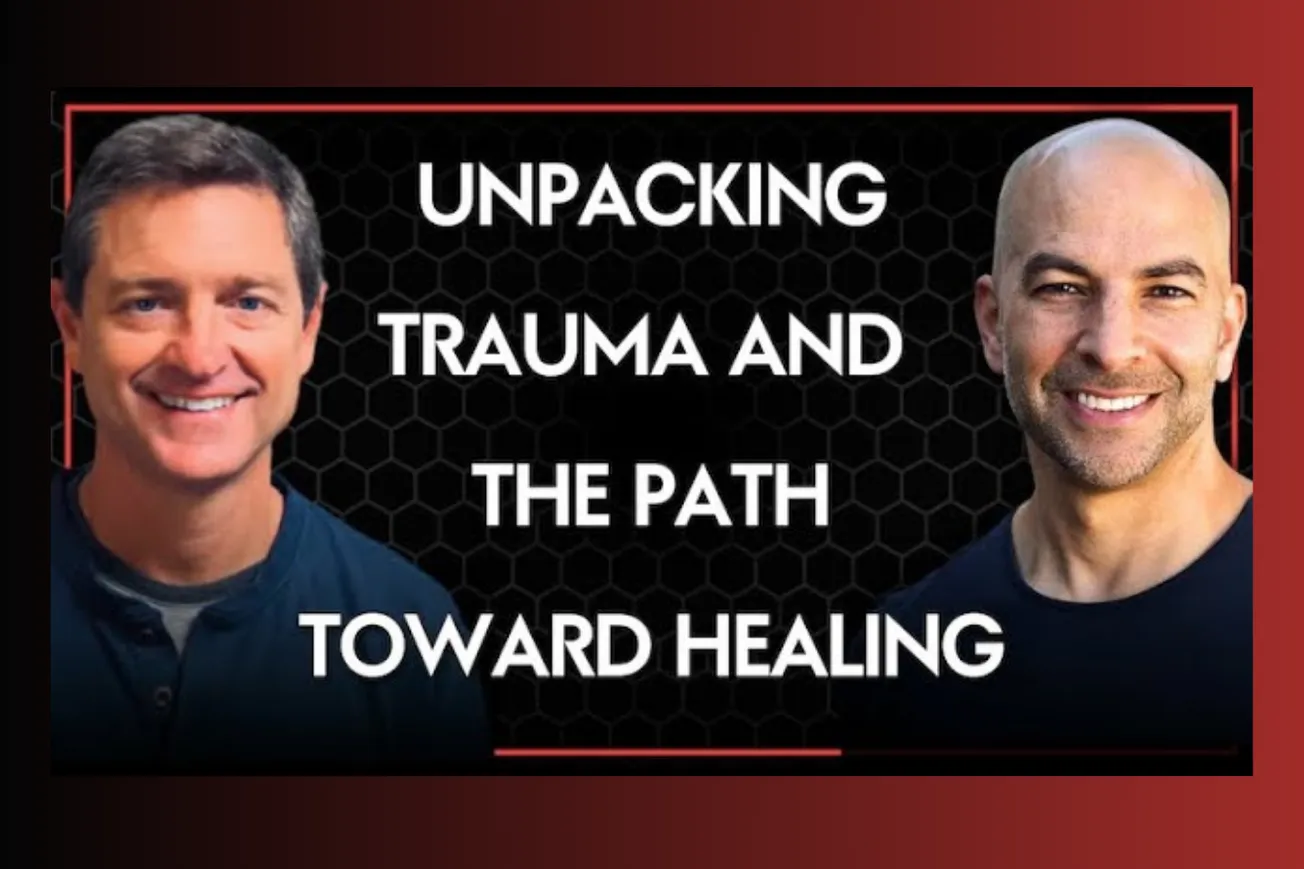Table of Contents
A comprehensive exploration of trauma therapy, residential treatment, and the path from disconnection to authentic healing through vulnerability and professional guidance.
Key Takeaways
- Trauma is defined as "moments of perceived helplessness" that activate the limbic system, regardless of event severity
- The trauma tree framework maps five roots (abuse, neglect, enmeshment, abandonment, tragic events) to four branches (codependency, addiction, attachment issues, survival strategies)
- Residential treatment programs like The Bridge to Recovery use controlled vulnerability and group dynamics to break through protective behavioral patterns
- Maladaptive coping strategies were once ingenious survival mechanisms that now create problems in adult relationships and daily functioning
- Individual therapy can be effective but may require residential immersion for deeply entrenched trauma responses and protective patterns
- Integration involves expanding your window of tolerance to vulnerability while maintaining awareness of protective parts without eliminating them entirely
- Finding qualified trauma therapists requires looking for depth over breadth in specializations and evaluating whether sessions challenge you appropriately
- Generational trauma patterns continue until someone actively chooses to break the cycle through conscious healing work and vulnerability
Understanding Trauma Beyond Traditional Definitions
- Modern trauma therapy embraces "moments of perceived helplessness" rather than requiring catastrophic events, recognizing that any situation activating the limbic system can create lasting impacts on behavior and relationships. This framework validates experiences that might not qualify as "big T" traumas but still shape protective responses.
- The distinction between explicit trauma (clear memories and images) and implicit trauma (body sensations, anxiety, behavioral patterns) helps explain why some people struggle with symptoms without obvious precipitating events. Many clients initially claim "nothing happened to me" while displaying clear trauma responses.
- Childhood neglect represents something that "failed to happen" rather than something that occurred, making it particularly difficult to identify and address. A child being bullied at school while parents remain oblivious creates ongoing limbic activation without clear resolution.
- Complex post-traumatic stress from repeated "thousand paper cuts" often proves more challenging to treat than single-incident trauma because the nervous system develops sustained hypervigilance and multiple protective strategies over extended periods.
- "Nothing happened to me I don't think about that why do I need to talk about that," represents common initial resistance, yet these same individuals often experience anxiety, control issues, and relationship difficulties stemming from unprocessed experiences.
- The trauma tree model provides causality framework connecting childhood wounding events (roots) to adult manifestations (branches), though the relationship isn't always linear or predictable between specific traumas and resulting behaviors.
The Bridge to Recovery Treatment Model
- Residential treatment for disconnection addresses various maladaptive coping mechanisms including substances, screens, sex, relationships, ego, and anger as different expressions of the same underlying need to avoid vulnerability. Groups typically include diverse backgrounds united by disconnective patterns rather than specific addictions.
- "This is hard work and this is uncomfortable and if it wasn't there'd be a line of people all the way back up that hill trying to get in here but if you noticed there's no line to get in here," illustrates how the difficulty itself serves as both barrier and therapeutic tool.
- Group therapy becomes central because individual protective strategies emerge most clearly in interpersonal dynamics where vulnerability naturally arises. Living, eating, and sharing space with others creates authentic situations where guards and defensive patterns activate.
- The first week focuses on "getting your history straight" through telling life stories within the trauma tree framework, shifting from "what's wrong with me" to "what happened to me" while maintaining accountability for current behaviors and choices.
- Controlled vulnerability introduction through shared living, mandatory group participation, phone removal, and structured activities creates therapeutic pressure without overwhelming the nervous system. The artificial environment allows practice of new responses.
- All staff members have completed the program themselves, ensuring that therapists ask nothing of clients they haven't experienced personally. This shared vulnerability creates trust and authentic modeling of the healing process.
Mapping Personal Wounds Through the Trauma Tree
- The five roots encompass abuse (physical, emotional, social, religious), neglect (failure of needed experiences), enmeshment (boundary violations and age-inappropriate roles), abandonment (physical or emotional unavailability), and tragic events (life-altering incidents that divide experience into before and after).
- Abandonment serves as the umbrella wound because all other traumas involve some form of abandonment - when someone abuses you, they abandon their protective role. This abandonment creates the core wound around which other protective strategies develop.
- Enmeshment often occurs in successful families where outcomes matter more than process, creating "mini-me" relationships instead of individuated development. Children either "drink the Kool-Aid" and lose themselves or rebel completely, neither representing authentic development.
- The four branches represent ingenious damage control strategies: codependency (outer reach for inner security), addictive patterns (powerless compulsive behaviors), attachment issues (anxious, avoidant, or disorganized connection styles), and various survival strategies developed to manage vulnerability.
- These adaptive behaviors deserve respect as brilliant solutions created by children managing impossible situations. "It's an old friend that served me well and perhaps now it's making life hard," captures the complexity of releasing protective mechanisms that once provided survival.
- The manifestations aren't character defects but skills developed under pressure that now create problems in adult contexts where different responses would be more effective and appropriate.
The Adaptive Child and Protective Mechanisms
- Every person contains three aspects: the original inner child (authentic self), the wounded child (holding pain and trauma responses), and the adaptive child (protective strategies and survival mechanisms developed to manage threats and maintain safety).
- Protective parts or "guards" emerge to prevent vulnerability because early experiences taught that being vulnerable leads to pain, abandonment, or danger. These parts develop specific strategies like people-pleasing, perfectionism, control, anger, or withdrawal to maintain perceived safety.
- "We got to keep Jeff from being vulnerable right we got we've had a bad experience with vulnerability so all these parts of me that step in to my driver's seat they've got a goal," explains how protective mechanisms organize around avoiding re-experiencing helplessness.
- The goal isn't eliminating protective parts but changing their relationship with the core self and expanding tolerance for appropriate vulnerability in safe contexts. These parts need appreciation for their service while learning when their interventions aren't necessary.
- Shame manifests in two primary ways: superiority (grandiosity, control, perfectionism, criticism) and inferiority (worthlessness, self-attack, isolation). Both represent attempts to manage core feelings of defectiveness or unworthiness stemming from early wounding experiences.
- Integration work involves recognizing when protective parts activate, understanding their historical purpose, and gradually expanding capacity to choose responses rather than react automatically from protective strategies that may no longer serve current circumstances.
Group Dynamics and Therapeutic Rules
- Eye statements rather than "we" or "you" language forces personal ownership of experiences and reactions while creating safety for others to share without being generalized about or spoken for by other group members.
- The "no minimizing" rule prevents adaptive strategies that diminish experiences to avoid feeling their full impact. Minimizing serves as protective mechanism but blocks necessary emotional processing and validation of personal truth and experience.
- Standing to get your own tissues breaks automatic caretaking patterns that prevent others from experiencing their emotions fully. "The very act of handing someone a Kleenex can cut off something that maybe have been 25 years in the making," demonstrates how rescue behaviors interrupt healing.
- No feedback to feedback prevents defensive responses that shut down vulnerability after someone shares courageously. The rule creates space for authentic sharing without immediate self-protection or correction of others' perceptions.
- Present and supportive participation requires staying in the room physically and emotionally rather than escaping to bathrooms or mental distractions when difficult material emerges that triggers personal material or protective responses.
- These rules create emotionally safe containers where authentic expression becomes possible through structure that prevents typical defensive maneuvers and protective strategies from derailing the therapeutic process.
Individual Therapy Versus Residential Treatment
- Residential treatment provides immersion that accelerates healing through constant therapeutic environment, similar to learning language through total immersion rather than weekly lessons. The controlled environment prevents typical escape routes and distractions that maintain disconnection patterns.
- Individual therapy works effectively but faces challenges when clients return to same environments and relationships that trigger protective responses. The gap between knowing what to do and being able to implement changes often requires more intensive intervention.
- "You're either going to deal with it or it's going to deal with you," emphasizes the inevitability of addressing unresolved trauma whether through conscious choice or continued unconscious manifestation in relationships and life patterns.
- Finding qualified therapists requires looking for depth over breadth in specializations, personal referrals, and willingness to challenge clients appropriately. Effective therapy should feel challenging and exhausting rather than comfortable validation sessions.
- Breakthrough moments often occur through loving confrontation that collapses false belief systems, but these require prepared minds actively engaged in the healing process rather than passive participation or intellectual understanding alone.
- The decision between individual and residential treatment depends on severity of symptoms, available support systems, ability to implement changes in current environment, and level of motivation for transformation rather than symptom management.
Breaking Generational Patterns and Building Connection
- Generational trauma continues until someone consciously chooses to break cycles through personal healing work. Parents can't give children emotional safety and connection they haven't developed within themselves, making personal work essential for family healing.
- Healthy boundaries in relationships focus on personal choices and consequences rather than trying to control others' behaviors. Effective boundary setting often avoids "you" language and focuses on personal actions and responses to others' choices.
- Vulnerability remains essential for authentic connection but requires two willing participants. One person's healing can change relationship dynamics, but sustainable intimate connection requires mutual willingness to be emotionally honest and present.
- Connected relationships involve sharing truth about internal experiences without demanding specific responses from partners. Saying "this scares me to death" represents authentic vulnerability that creates intimacy when received with empathy and care.
- Integration means developing capacity to notice protective parts activating and choosing conscious responses rather than automatic reactions. This creates space between triggers and responses where authentic choice becomes possible instead of compulsive behavior patterns.
- The healing journey continues throughout life as new situations trigger old wounds, but integrated individuals develop internal resources to navigate challenges while maintaining connection to themselves and others through conscious presence and appropriate vulnerability.
Trauma healing requires courage to face protective mechanisms that once ensured survival but now limit authentic connection and personal growth. The path demands both professional guidance and personal commitment to vulnerability as the gateway to genuine transformation and relational intimacy.









